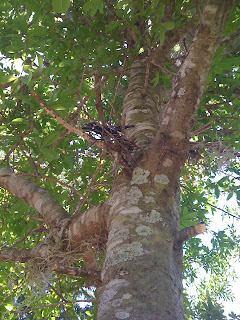First, my apologies for taking a week off. I came down with a super-flu last Saturday, which I wrestled with all week, and ended up with a raging sinus infection. Needless to say, no caching. I actually started a post last Sunday about geohazards, but I never finished it. I'll live to post another day.
Second, I finally managed to update my stats...but I still can't figure out how to change the colors. The background shouldn't be silver. I messed with the html one day, but I did more damage than good.
Now, for the caching. I went out today to do some shopping in the Oviedo area. I wasn't really planning to cache, but I already knew there were a few on my way, and I couldn't help myself. I ended up with four finds and one less travel bug.
The first one was way easy: a 35mm film cannister stuffed inside a brick wall. Forgot to snap a photo. It was rated a 2 for difficulty, not really sure why.

This is actually the last one I did, but I'm kind of a spaz when it comes to loading photos. They never go in the order I want. I really need to brush up on my html so I can stop relying on the "wizard."
This is another one that was rated a 2 for difficulty. I can see how it
could be difficult, but it was practically out in the open. I suppose when the vines are thicker this might be a tough find.
I'm not sure what the cache container is, it's not something I have seen before. It was a small plastic cylindar, about the size of a large pill bottle but shorter, with a twist-off top and key chain. The key chain was perfect for attaching it to this fence. And! It was bone-dry inside. That's so rare.
My third cache was a mind-numbingly easy hide-a-key under a newspaper stand. The only hard part was waiting out random muggles. Why do people always feel a need to congregate randomly around cache locations? They probably don't like me watching them intently from behind my tinted windows...whatever, they're in my way.

This was another first in terms of containers. It's not really that cool, just a small, rusty, metal canister. It was perched in the guardrail near this little pond. Not tough to find, but blended in well enough that I doubt muggles would think to grab it.
I tend not to pay much attention to the descriptions, but this one included quite a tale. I leave you with an exerpt:
Antoinette's whole family was against the marriage so her and Ed ran away.
The family wouldn't leave it at that and followed. They caught up here at what
is now known as Lovers Leap. To show the family their undying love for each
other they lept from where the cache is now hidden. Since the slope is not
vertical they rolled to the bottom. When they stood up covered in sand spurs,
spanish needles, caesar weed burs, fire ants, and pond scum the family gave
their approval to be married.














































